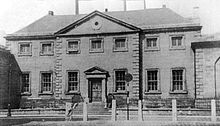Westmoreland Lock Hospital
| Westmoreland Lock Hospital | |
|---|---|
 |
|
| Geography | |
| Location | Townsend Street, Dublin, Ireland |
| Organisation | |
| Hospital type | Specialist |
| Services | |
| Speciality | Venereal disease |
| History | |
| Founded | 1792 |
| Closed | 1954 |
| Links | |
| Lists | Hospitals in the Republic of Ireland |
The Westmoreland Lock Hospital was a hospital for venereal disease originally located at Donnybrook and later moved to Lazar's Hill (now Townsend St.), Dublin, Ireland.
There was a hospital to treat venereal disease in Donnybrook since the middle of the 18th century, but its distance from the city centre made it unattractive for physicians. At the same time the Hospital for Incurables in Townsend St. was running out of space. It was decided to swap locations, which benefited both hospitals.
The new hospital was founded in 1792, when Westmoreland was Lord Lieutenant of Ireland, and was located at the corner of present-day Townsend St. and Luke St., where its foundations were excavated in 1998. It later operated under the name of the Hospital of St. Margaret of Cortona. The 'Lock Hospitals' were developed for the treatment of syphilis following the end of the use of lazar hospitals, as leprosy declined. In the 18th century another Lock Hospital was located in Clarendon St., Dublin.
Initially the hospital treated 300 people of both sexes. This was later reduced to 150 beds and from 1820 only women were admitted (males were sent to Dr Steevens' Hospital and the Richmond Hospital). It was supported by the state from the outset. Catholics and Protestants were segregated. In the 19th century most of the patients were prostitutes, a consequence of the large military presence in the city - Dublin having the "largest garrison of the British army at home or in the colonies" (Under-Secretary Thomas Larcom). It became part of the objectives of the hospital governors to prevent the transmission of venereal disease to troops stationed in the city, and the hospital was provided with a grant from the government to effect this.
In 1794 the Lock penitentiary opened, which catered for women who had been discharged from the hospital. Other destinations for those discharged were the Lying-in hospital (now the Rotunda Hospital), the work-house, or the Cork Street Fever Hospital, Dublin. The hospital never had power to hold women against their will.
...
Wikipedia
